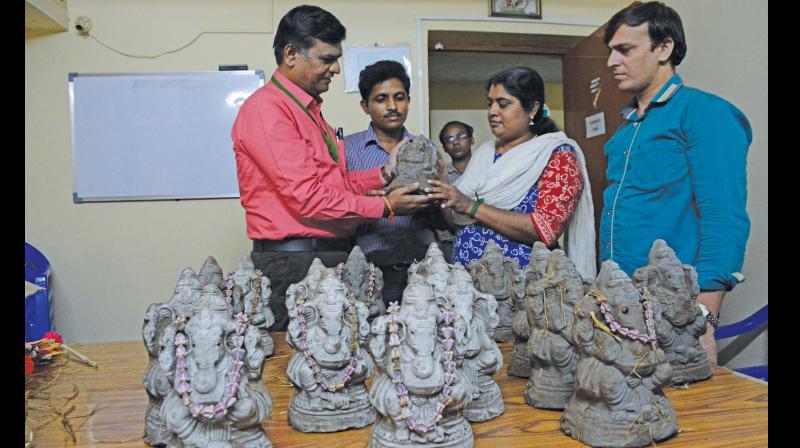Eco-friendly Vinayakas make inroads into Namma Chennai

Vinayaka Chaturthi celebrations in the city have undergone various changes in tune with times. Till the 1980s, Chennaiites celebrated the festival only at home by buying small clay idols of Ganesha, performing pujas and then immersing them in sea/wells/lakes after two days. The colourful umbrellas accompanying the idols came in different sizes and shapes, which, usually, were selected by the young ones of the family.
In the 1990s, the festival took a different turn with Hindu Munnani placing huge colouful Vinayaka idols at vantage points of the city and throughout the state. Strict rules and regulations came into place as clashes were reported between two communities on processional routes. Years rolled by and with police cracking the whip on violators, things fell into place and Vinayaka Chaturthi processions faced no major problem.
Meanwhile, questions were raised over idols made of Plaster of Paris (PoP) or painted with chemical colours being installed in the city and polluting the water bodies during immersion. Soon, with increasing awareness, PoP idols were shown the door and papier-mache idols made an entry. Every year, the Tamil Nadu Pollution Control Board issues guidelines for immersion of idols in water bodies. Only idols made of clay and other eco-friendly materials like tuber flour or sago waste can be immersed in water bodies.
Last year, the Madras high court dismissed a plea seeking to quash a GO which imposed conditions on installation and procession of Vinayaka idols. The petitioner had said the GO was an interference of state with the affairs of religious management was ultra-virus and unconstitutional. The conditions were violative of Article 14 of the Constitution of India, he had added in his petition. However, the division bench asserted that at any stretch of imagination it cannot be said to be violative.
Idols are now installed only after obtaining the requisite permission from the civic body, police, fire services personnel and the pollution control board. The Hindu Munnani, planning to install over 5,000 idols in the city this year, has said it uses clay for small idols and papier-mâché or tapioca for bigger idols ranging up to 12 or 13 feet. They have installed idols made of dates, dry fruits and vegetables and use natural dyes to enhance the beauty of the idols.
While huge idols are taken out in a procession and immersed in the Bay at specified locations, the huge quantity of garbage left behind is appalling.
However, there seems to be a marked shift in the attitude of people towards celebrating the festival in an eco-friendly manner. People, apartments and gated communities in the city have made a green choice. They go for idols that are bio-degradable and made of non-polluting materials. Idols made of paper pulp, hay, clay and tapioca starch are in big demand now. Some go for 'Seed Vinayaka' and want to see saplings sprout from the idol immersed in a pot of soil.
With heightened awareness, Chennaiites must strive to celebrate the festival without polluting the environment while authorities must ensure that rule-breakers are not spared at any cost.

